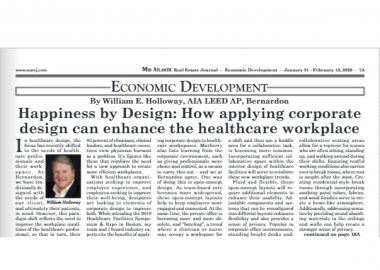Bill Holloway Published in Mid Atlantic Real Estate Journal 2020 Economic Forecast

Happiness by Design: How Applying Corporate Design Can Enhance the Healthcare Workplace
In healthcare design, the focus has recently shifted to the needs of healthcare professionals and their workspace. At Bernardon, we have traditionally designed with the needs of our client, and ultimately their patients, in mind. However, this paradigm shift reflects the need to improve the workplace conditions of the healthcare professional, so that in turn, their patients can benefit as well.
Oftentimes, healthcare facilities can be chaotic environments wherein professionals face challenges of administering effective care within a not-so-effective workspace. Yet, what we see is often just a glimpse into a much larger issue. Those who spend days and nights working in hospitals, medical offices, and care centers face the limitations of their workspace on a daily basis. Whether its dealing with spatial issues like overcrowding or lack of resources within the work areas, healthcare professionals often endure less-than-ideal working conditions along with the daily challenges of providing optimum healthcare services to patients and residents.
We anticipate that healthcare facilities will respond to this need and seek to implement design solutions that address both the concerns of the staff and the patients in order to create a healthier, happier environment. Moreover, healthcare employers are seeking ways to attract and retain talent, and providing an optimal workspace is surely one of many ways to accomplish this. So, where are designers gathering inspiration for these workspace improvements? It might be considered a surprising source: the corporate office.
Applying Concepts from Corporate Design
This heightened focus on the healthcare workspace involves taking into consideration the challenges of healthcare professionals. Healthcare design consultant Sara Marberry has reported that nurses often feel undervalued and more than half suffer from musculoskeletal pain. Whereas Healthcare Design Magazine shares that 83 percent of clinicians, clinical leaders, and healthcare executives view physician burnout as a problem. Its figures like these that reinforce the need for a new approach to create more efficient workplaces.
With healthcare organizations seeking to improve employee experience, and employees seeking to improve their well-being, designers are looking to elements of corporate design to improve both. While attending the 2019 Healthcare Facilities Symposium & Expo in Boston, my team and I heard industry experts cite the benefits of applying corporate design to healthcare workspaces. Marberry also lists learning from the corporate environment, such as giving professionals more choice and control, as a means to carry this out – and we at Bernardon agree. One way of doing this is open-concept design. As team-based care becomes more widespread, these open-concept layouts help to keep employees more engaged and connected. At the same time, the private office is becoming more and more obsolete, and “hoteling”, a trend where a clinician or nurse may occupy a workspace for a shift and then use a huddle area for a collaborative task, is becoming more common. Incorporating sufficient collaborative space within the interior design of healthcare facilities will serve to reinforce these new workplace trends.
Fluid and flexible, these open-concept layouts will require additional elements to enhance their usability. Adjustable components and systems that can be reconfigured into different layouts enhances flexibility and also provides a sense of privacy. Popular in corporate office environments, standing-height desks and seating arrangements allow for a reprieve for nurses who are often sitting, standing up, and walking around during their shifts. Ensuring restful working conditions also carries over to break rooms, where rest is sought after the most. Creating residential-style break rooms through incorporating soothing paint colors, fabrics, and wood finishes serve to create a home-like atmosphere. Additionally, addressing acoustics by providing sound-absorbing materials in the ceilings and walls can help create a stronger sense of privacy.
Cultivating More Happiness in Healthcare
Finding happiness in work is a goal across many professions. Whether influenced by corporate design or through industry trends, providing improved workspace design for healthcare professionals will serve to impact the overall atmosphere and morale of the healthcare environment. The American Hospital Association recently reported that nearly 60% of hospital executives anticipate that their hospital will implement strategies to increase employee job satisfaction. It’s important to note that employee satisfaction can tie back to patient satisfaction. By implementing more employee-focused design, including collaborative workspaces and more enhanced break rooms, healthcare professionals can experience a happier, healthier workplace, and their patients can reap the benefits of a happier healthcare experience, too.
Written by William E. Holloway, AIA LEED AP; Originally published in the Mid Atlantic Real Estate Journal 2020 Economic Forecast.
< Return to Noteworthy